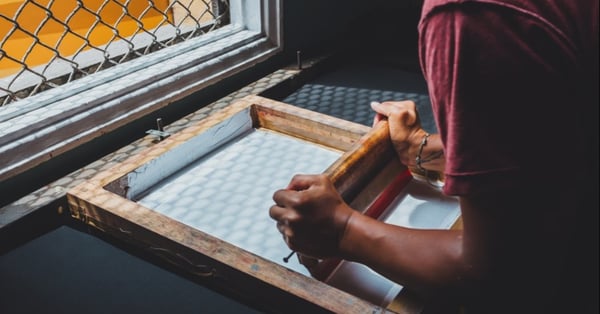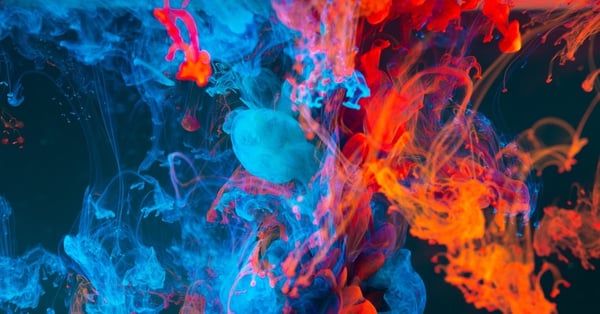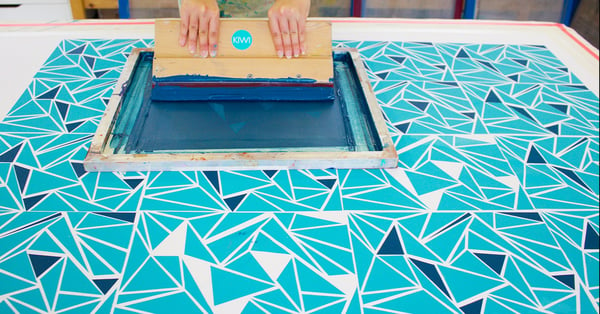Screen printing is an effective technique for creating vibrant canvases, posters, artwork, fabrics and textiles.
The screen printing technique uses mesh to transfer ink, except in areas blocked by a stencil. The process is also called serigraphy or silkscreen printing.
It’s a physical technique that has risks affecting a print's quality. Here are three common screen printing problems and solutions to ensure your print turns out sharp.
- Problem One: The Image Has Bled and Ruined the Design
- Problem Two: Loss of Detail
- Problem Three: The Ink Viscosity Is Off
Problem One: The Image Has Bled and Ruined the Design
When screen printing, certain areas of your chosen canvas are blocked out using stencils. Stencils can be created in various ways depending on the materials used, but it's essential to prepare them correctly.
Different stencilling techniques include:
- Using masking tape or vinyl to cover the desired areas of the screen.
- Painting the stencil onto the mesh using 'screen blockers' such as glue.
- A light-sensitive emulsion is used to create a stencil, which is then developed.
Designs made using the screen printing technique can use several shades of inks.
Colours must be applied in individual layers for multicoloured items, using separate stencils for each ink.
Each scenario has the potential for bleeding, where the ink may run, leaving your intricate design in an inky blur.
Solution
In screen printing, ink is forced through the mesh onto the printing surface using a squeegee.
Squeegeeing helps to thin or 'shear' the ink, allowing it to be released easily from the screen.
A sharp squeegee edge is preferred, as they won't have any nicks that could get caught on the fabric. If the edge is worn or rounded, it makes it harder for the ink to clear the screen, making the print feel rough to the touch.
The mesh screen should be taut enough to quickly rebound or "snap" back after the squeegee has passed over it. The screen's rapid upward movement helps cleanly separate the ink from the mesh, preventing it from bleeding or smudging onto blocked areas.
Tired of Ink Bleeding and Ruining Your Prints?
We have the perfect asset for you to create a brilliant piece of print without the hassle of screen printing. Download the free guide today.
Problem Two: Loss of Detail

Screen printing is used for many repeat items but takes significantly longer than its digital counterparts. So when your intricate stencil details aren't coming through, it can be time-consuming and challenging to overcome.
While the complexity of the process does mean there's a limit to the number of colours the printer can use, it's relatively cost-effective for large orders. It allows for more intense colouring than you can achieve with other methods.
However, you might be losing important details in the final print for several reasons, including:
- Inconsistent tension across the mesh screen can lead to uneven ink application and registration issues, resulting in variations in print quality.
- Uneven pressure applied by the squeegee can cause variations in ink deposition, resulting in differences in colour density or clarity across prints.
- Variations in ink viscosity or composition can affect how the ink flows through the mesh screen and adheres to the printing surface, leading to differences in print quality.
- Misalignment of screens during printing can result in blurred or misregistered prints, especially in multicoloured designs.
Solution
A screen tension metre can be an invaluable tool to keep print quality sharp.
Screens loosen over time due to the constant pressure of the squeegee. When screen tension becomes too low, the mesh can shift during printing, causing the edges of the print to blur.
Printers can avoid this problem by checking their screens with a tension meter before every printing job. Screens with slack tension should be re-tensioned or replaced accordingly to ensure your print continues to wow.
Carefully select and maintain squeegees suitable for the ink and substrate, ensuring consistent hardness and edge profiles. Regular inspection and replacement of worn or damaged squeegees are essential. Maintaining consistent squeegee angle, pressure and print speed, along with regular equipment calibration, helps ensure uniform ink distribution.
Implementing registration systems, such as pin or mechanical registration, ensures precise screen alignment before printing. Incorporating registration marks on screens and substrates aids in alignment, serving as reference points for adjustments.
Problem Three: The Ink Viscosity Is Off

If the ink consistency is off, it can create less-than-desirable results for your screen printing project. Screen printers refer to inks as either short or long.
- A short ink tends to drop in a blob.
- A long ink is stringy like syrup.
Short ink is ideal for screen printing, followed closely by water-based ink, an eco-friendly alternative.
Its lower viscosity facilitates smooth flow through the mesh screen, producing consistent ink deposition and sharper prints. Short ink's ability to penetrate substrate fibres enhances detail reproduction, making it ideal for intricate designs and small text.
The ease of flow from short ink also enables faster production speeds without compromising print quality, reducing downtime for cleaning and maintenance.
Solution
Additives may need to be mixed into the ink to thin or tailor it to the project, such as sparingly adding a low-bleed additive.
Additives can sometimes thin the ink beyond the ideal viscosity, allowing it to bleed beyond the bounds of a stencil during printing.
A rheometer will help to identify the right consistency. Ink should be thoroughly mixed, aiming for a paste-like viscosity to create vibrant printed materials.
Explore Other Printing Techniques
Screen printing is excellent for fabric, abstract posters and logos but doesn't translate the finer details of other printing techniques. Books, leaflets, posters, cards, signs, brochures and prospectuses rely on print to convey their message. Paired with the common screen printing problems mentioned, looking elsewhere for your printing needs might be better.
Some people claim that the digital world has destroyed the print industry, but that just isn't true.
It's still as relevant as ever in your marketing strategy. That's why we created a guide to all the printing techniques you can utilise for your business. Click below to get access.

